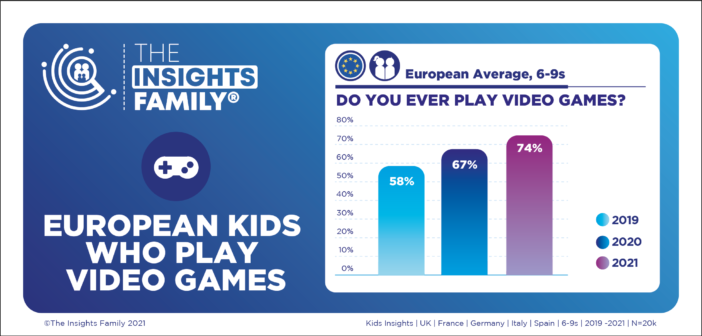Kids entertainment & gaming
Is now the time to redefine the term audience?
When it comes to kids’ entertainment, it can now be argued that gaming is quickly becoming number one.
Whether it is the rise of digital currencies, a push for sustainability or disrupting the way content is created, across the world, tech-savvy kids are driving change and innovation. Their voices are becoming stronger and more relevant.
On average, 81% of 6–9-year-olds in Europe have stated that they play video games, and only 15% of US teens do not engage with video games in some capacity. Meanwhile, 78% of 6–9-year-olds in the UK even play video games with their parents.

European kids who play video games
However, the definition of a video game has shifted. It is no longer a closed experience; they are open worlds with activities such as shopping and entertainment all built in. Often described as the first step towards a ‘Metaverse’, platforms such as Roblox and Fortnite are now virtual places where individuals, brands, and creators come together. These platforms provide almost unlimited interactive experiences and stories to be shared with friends.
This generation of kids are growing up as digital natives and are as comfortable existing in a virtual world as they are in the physical. They also expect a seamless integration between the two.
Growth of esports in Kids entertainement and gaming
With access to more technology and content, kids have far greater choice of what they watch, and when they watch it than ever before. One of the most interesting trends over the last few years is the growth of esports. As children engage even more with video games, this phenomenon has slowly become part of the mainstream kids’ ecosystem. Already 21% of kids aged 12-16-years-old in Europe watch esports and 7% even take part.
While physical sporting events were halted amidst the pandemic, the League of Legends European Championship – streamed live on Twitch – boasted the league’s highest ever viewing figures, raking in an average of 819,400 viewers for the final in April 2020.
However, the momentum esports garnered during the shutdown merely accelerated an existing, larger trend at play.
As esports revolves around online platforms, kids have the ability to interact and relate further to “e-athletes” more than in traditional sports. With seamless opportunities to get involved, it is potentially only a matter of time before we see a wave of global kid esports superstars emerging.
Kids entertainment and gaming : what this means to TV producers…
In an effort to grow the audience, producers began to work on the integration of game plots into scripts. HBO began shooting “The Last of Us” in the summer of 2020, where the series will cover the events of the original game for the PlayStation and most likely will the forthcoming game sequel “The Last of Us 2”. Additionally, Arcade ‘run and gun’ classic Contra is getting a live-action film in China, produced by Beijing Starlit Movie and TV Culture. New Line Studio is also currently working on a Mortal Kombat series, and is planning to debut in theatres and on HBO Max.
Netflix are also getting in on the gaming action. “The Witcher” enjoyed the company’s biggest debut for a new series and is still one of the most watched shows of 2020. In 2019 “Pokémon Detective Pikachu” also enjoyed an impressive theatrical run too, generating more than $430 million in box office revenue worldwide.
In terms of preschoolers, kids, and tweens focused cinema, the Sonic the Hedgehog movie was a big commercial success. As well as Pixar’s “Wreck-It Ralph” which was based around the video game world too.
TV is adapting to be more attractive for a younger audience. Content producers are adapting and following the latest trends. Pokémon Detective Pikachu, popular across all children aged 3-18 in the UK, watched by 1-in-10 kids in cinemas as it was released, and watched 55% by boys. In 2020, the release of Sonic the Hedgehog was also extremely popular amongst UK kids, with 12% of 3-18s reporting to watch it in cinemas when it premiered and being favoured equally by both boys and girls.
So, what can TV learn from esports and gaming ?
Television still commands a huge audience from young viewers – with kids aged 6-9 spending 8h:50 min per week watching TV compared to 6h:44 min per gaming in Europe. In general, kids have far greater influence and choice as to which TV platforms they are watching, and when they are watching their favourite content.
Streaming platforms have a particularly large reach, with 59% of kids aged 3-18 reporting to using Netflix across Europe, as well as 43% reporting to use Amazon Prime (Video) over the last 3 months.
However, the rise of gaming and esports illustrates how this generation of children no longer want to just passively consume content, they want to play a role in the outcome, help shape the direction and make it personal to them.
Kids want to become content co-creators, co-syndicates, and even co-critics. TV platforms and brands are experimenting with ways to tap into this trend. For example, Disney+’s latest feature enables kids, parents, and families to watch remotely in viewing groups, sharing virtual reactions in real-time. This same ability to co-view and share an experience with others is one of the reasons behind Twitch’s rise to popularity – the premier platform in the esports industry for watching live content, used by 1 in 10 teens across the UK and Germany.
We have also seen Netflix experiment with interactive ‘choose your own story’ episodes, across their Bear Grylls and Black Mirror content.
Will we see more content creators utilise Augmented Reality (AR) or Virtual Reality (VR) in the future? Further advancements in technology could be used to enable viewers to control the story and deepen their connections with the characters.
While this technology may still be in its infancy, it is important creators and platforms experiment to stay ahead of the curve and consider: is now the time to redefine the term audience?
The Insights Family® survey more than 362,100 kids and more than 176,800 parents every year across 17 countries.
For more details visit: https://theinsightsfamily.com/
TV Trends in your inbox? Fill in your details to subscribe to the MIP Newsletter →
For more information on TV Trends, attend MIPCOM and MIPTV
You can read also : Kid’s audience & Metaverse – The latest trend in virtual reality
Financing TV Production : The Magic Money Tree Grows…
Super aggregators of TV content




